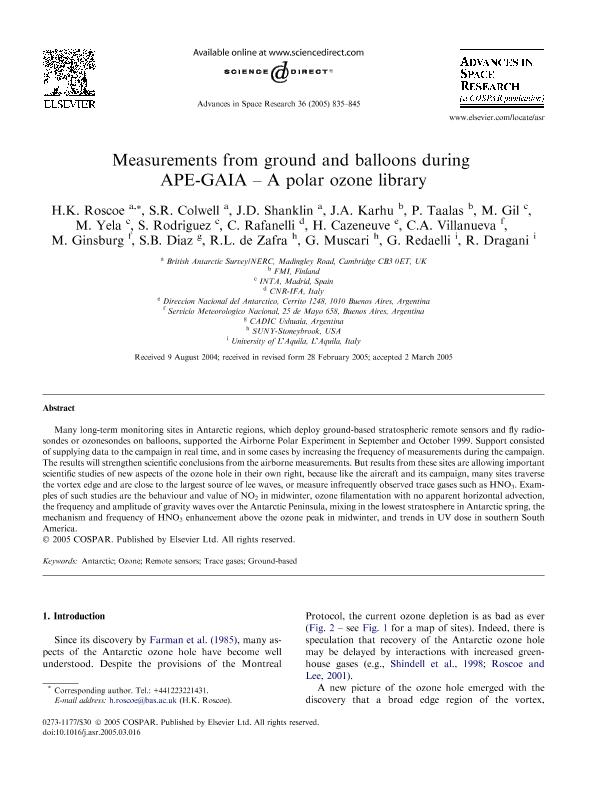Artículo
Measurements from ground and balloons during APE-GAIA - A polar ozone library
Roscoe, H. K.; Colwell, S. R.; Shanklin, J. D.; Karhu, J. A.; Taalas, P.; Gil, M.; Yela, M.; Rodriguez, S.; Rafanelli, C.; Cazeneuve, H.; Villanueva, C. A.; Ginsburg, M.; Diaz, Susana Beatriz ; De Zafra, R. L.; Muscari, G.; Redaelli, G.; Dragani, R.
; De Zafra, R. L.; Muscari, G.; Redaelli, G.; Dragani, R.
 ; De Zafra, R. L.; Muscari, G.; Redaelli, G.; Dragani, R.
; De Zafra, R. L.; Muscari, G.; Redaelli, G.; Dragani, R.
Fecha de publicación:
12/2005
Editorial:
Elsevier
Revista:
Advances in Space Research
ISSN:
0273-1177
Idioma:
Inglés
Tipo de recurso:
Artículo publicado
Clasificación temática:
Resumen
Many long-term monitoring sites in Antarctic regions, which deploy ground-based stratospheric remote sensors and fly radiosondes or ozonesondes on balloons, supported the Airborne Polar Experiment in September and October 1999. Support consisted of supplying data to the campaign in real time, and in some cases by increasing the frequency of measurements during the campaign. The results will strengthen scientific conclusions from the airborne measurements. But results from these sites are allowing important scientific studies of new aspects of the ozone hole in their own right, because like the aircraft and its campaign, many sites traverse the vortex edge and are close to the largest source of lee waves, or measure infrequently observed trace gases such as HNO 3 . Examples of such studies are the behaviour and value of NO 2 in midwinter, ozone filamentation with no apparent horizontal advection, the frequency and amplitude of gravity waves over the Antarctic Peninsula, mixing in the lowest stratosphere in Antarctic spring, the mechanism and frequency of HNO 3 enhancement above the ozone peak in midwinter, and trends in UV dose in southern South America.
Palabras clave:
Antarctic
,
Ground-Based
,
Ozone
,
Remote Sensors
,
Trace Gases
Archivos asociados
Licencia
Identificadores
Colecciones
Articulos(INGEBI)
Articulos de INST.DE INVEST.EN ING.GENETICA Y BIOL.MOLECULAR "DR. HECTOR N TORRES"
Articulos de INST.DE INVEST.EN ING.GENETICA Y BIOL.MOLECULAR "DR. HECTOR N TORRES"
Citación
Roscoe, H. K.; Colwell, S. R.; Shanklin, J. D.; Karhu, J. A.; Taalas, P.; et al.; Measurements from ground and balloons during APE-GAIA - A polar ozone library; Elsevier; Advances in Space Research; 36; 5; 12-2005; 835-845
Compartir
Altmétricas



